Shading Nets Usefulness for Water Saving on Citrus Orchards under Different Irrigation Doses
A. Aboutallah1 , R. Salghi1 * , A. El Fadl2 , B. Hammouti3 , A. Zarrouk3 , A. Atraoui2 and Y. Ghnizar4 *
1
Equipe de Génie de l’Environnement et Biotechnologie,
ENSA, Université Ibn Zohr,
BP1136 Agadir
Morocco
2
Institut Agronomique et Vétérinaire Hassan II,
IAVCHA,
BP 121 Ait Melloul,
Morocco
3
LCAE-URAC18, Département de Chimie,
Faculté des Sciences,
Université Mohammed Premier,
BP 4808
Oujda
Morocco
4
GPA Group, 325,
Av Hassan II Agadir,
Morocco
DOI: http://dx.doi.org/10.12944/CWE.7.1.03
This work treats a comparative study of deficit irrigation and shading nets impacts on the citrus growth and fruit dropping, in order to save water without affecting physiological status and trees performances. The first dose (100%) is calculated using reference evapotranspiration (ETo - calculated using weather station), and crop coefficient (Kc) which varies according to physiological stage; the second is a double-dose (200%) and the third is a half-dose (50%); This study has shown that the application of half-dose using shade screens meets trees needs without causing adverse effect on crop performances; the soil water content and root hairs are well distributed laterally, the bulb’s depth and 90% of roots are located at 0-50 cm horizons. Shading net enhanced fruit growth and has mitigated fruit dropping phenomena by H≈50% for the treatment F 50%.
Copy the following to cite this article:
Abouatallah A, Salghi R, Fadl A, Hammouti B, Zarrouk A, Atraoui A, Ghnizar Y. Shading Nets Usefulness for Water Saving on Citrus Orchards under Different Irrigation Doses. Curr World Environ 2012;7(1):13-22 DOI:http://dx.doi.org/10.12944/CWE.7.1.03
Copy the following to cite this URL:
Abouatallah A, Salghi R, Fadl A, Hammouti B, Zarrouk A, Atraoui A, Ghnizar Y. Shading Nets Usefulness for Water Saving on Citrus Orchards under Different Irrigation Doses. Curr World Environ 2012;7(1):13-22. Available from: http://www.cwejournal.org?p=348/
Download article (pdf)
Citation Manager
Publish History
Select type of program for download
| Endnote EndNote format (Mac & Win) | |
| Reference Manager Ris format (Win only) | |
| Procite Ris format (Win only) | |
| Medlars Format | |
| RefWorks Format RefWorks format (Mac & Win) | |
| BibTex Format BibTex format (Mac & Win) |
Article Publishing History
| Received: | 2012-03-12 |
|---|---|
| Accepted: | 2012-04-14 |
Introduction
Water uptake for agriculture is very intensive in Souss Massa region (521Mm3 per year), where irrigation waters are almost exclusively pumped from the water table which is being depleted by 2 to 3 meter per year.1 The climate is very arid with rainfall of about 150-200 mm/year concentrated in winter and Evapotranspiration (ETo) of 1800 mm/year with more than 7 mm/day in the Summer, average winter temperatures can reach 5-7°C whereas average summer temperatures can be as high as 32-36 °C.2-3 Adding the effect of the foreseen climate change, the available water volumes are expected to shrink by 10-15% of the actual volumes in 2020 due to the falling groundwater levels and the reduction of the storage capacity of dammed lakes by siltation.4 The citrus sector in the Souss region occupies about 33 000 ha which represents about 40% of the whole citrus plantings in Morocco, and employing quasi permanent irrigation with very limited water resources. This has led to the use of low volume irrigation systems (i.e.; drip, microsprinklers etc.) by more than 80% of the citrus orchards.5
To sustain agriculture, it is particularly important to optimize crop yields by minimizing inputs, mainly water and nutrient application6; Irrigation practices for water saving need to be adopted in intensive horticulture of Souss Massa region, where there is strong competition for scarce water supplies. While, Water efficiency is a key concept to solve water-shortage problems in semiarid areas,7 Shading nets structures in semi-arid and arid environments can be considered as an intermediate solution for increasing water use efficiency and reducing plant water stress.8 It offer many advantages and environmental benefits,9-12 this is why an increasing area of crops, including citrus, is being grown under shading materials of various types, and growers need to know how these influence yield. Some authors reported that shading nets are helping to reduce wind speed within the foliage by about 40%,13 keep lower values of maximum daily shrinkage,14 maintain high leaf water content and better LAI - Leaf Area Index,15 reduce irradiance at the Earth’s surface,16 decrease crop transpiration by increasing stomatal diffusive resistance in leaves17 and reduce the daily sap17-18 flow. However the photosynthesis and integrated daily net CO2 uptake is maintained at high levels in shaded plants with respect to exposed trees,20 The shade provided by the net do not affect yield and internal fruit quality (ratio of sugar to acid) but may increase fruit average weight and diameter.14,21 Another common practice is the Improve of water-use efficiency by reducing the amount of water supply.25-27,31 Plants have developed various mechanisms to withstand water stress, such as higher root-shoot ratios, fewer and smaller leaves, concentrated solutes or increased activity of oxidative stress enzymes in leaf cells,22 nevertheless, rootstock characteristics are important factors influencing plant responses to water deficit.23 It is well known that water stress in citrus reduces stomatal conductance, transpiration rate and net assimilation of CO224-27; Some authors suggest that the Deficit Irrigation (DI) and regulated deficit irrigation (RDI) strategies can be applied in commercial orchards not only in case of water scarcity, but also as a tool to control vegetative growth improving fruit composition and reducing costs associated with the crop management.22 It was possible to save up to 18% of water, applying DI strategy, without any significant reduction in yield and fruit weight,28 Mid-summer RDI strategy allowed 20% water savings, with a reduction in tree growth but without any significant reduction in yield, fruit size nor in the economic return, and helped to improve water use efficiency.29 Another author did find that RDI with 50% of the crop ETc decreased the yield by 10% but wasn’t statistically significant,30 it is important to draw attention to the fact that fruit growth and flowering stages are the most sensitive periods in relation to irrigation water deficit and yield loss,31 a loss of water takes place from fruit to transpiring leaves during water stress,32 fruit dropping may happen as a result of this endogen competition33 or just a natural selection to keep a limited fruit number balanced to its reserves,34 thus water-sever stress applied during the flowering and fruit-growth phases affect significantly the yield, the growth and reduces fruit size causing important economic losses in orchards35,39; but when this degree of stress is applied during the maturity phase, it improves mainly fruit-quality parameters (total soluble solids, and titrable acidity in juice),26,27,32,40 other authors reported that DI and RDI decrease fruit size by 4% and fresh weight by 10%, but enhance total soluble solids by 10% and titratable acidity by 13% at fruit maturity.41 Although the amount of irrigation water would have a relative importance, but other variables such as the irrigation strategy, would decidedly influence prudent water management in semiarid areas,33 when using low watering frequency, Deficit irrigation reduces water use by 1250m3/ha, with similar yields in comparison to the fully irrigated trees.42 However, when reducing water supply, irrigation water salinity is very important factor that should be managed too, because it increases average crop root zone salinity and may result in a negative effect on crop yield.43 This work aims to compare the impact of three Deficit Irrigation strategies (200%, 100% and 50% doses) on performance and physiological status of “Afourer” mandarin, in order to streamline the water supply without adversely affecting the trees performances; shading nets were then used towards their usefulness when combined with water deficit.
Experimental
The experiment took place at two plots of 5 years old mandarin (Afourer) over an area of 8.5 ha. Planting density was 833 trees per hectare (2 m between trees and 6 m between rows). While the first parcel has trees in open field, the second parcel was under net. The plot is equipped with various instruments used for applied research and drip irrigation system. Each tree row has a single polyethylene pipe with self compensating online drippers that are placed at 1 meter from one to another on the pipe line and their flow is about 4 l/ hour at a pressure varying within the range of 1 to 4 bars, each tree has 2 drippers. The factor studied is the amount of water applied. All the other production practices (fertilization, protection against pests and diseases, weed control etc.) are optimal and were similar for the whole experimental plot. The three water regimes corresponding to the three treatments studied are defined based on Penman–Monteith evapotranspiration (ET) equation that predicts the rate of total evaporation and transpiration from the earth’s surface using commonly measured weather data (solar radiation, air temperature, vapor content, and wind speed).44 Citrus water requirement was then estimated using proposed FAO crop coefficient (Kc) which varies according to physiological stage.45
ETc (mm/day) = Kc x ETo (mm/day) .....1
The first dose is taken 100% of crop ETc, the second is a double-dose (200%) and the third is a half-dose (50%). The 100% dose computing is a function of the crop evapotranspiration lost during the day before, it was varying from 2.75 to 4 mm/ day because of ETo variations en Kc changes (0.5 during May and 0.6 from June).
Thus, our different treatments were:
- Control with trees irrigated based on 100% dose at open field (F100%)
- Treatment which received 200% dose at open field (F200%)
- Treatment undergoing 50% dose at open field (F50%)
- Control with trees irrigated based on 100%
- Treatment which received 200% dose shading net (S200%)
- Treatment undergoing 50% dose shading net (S50%)
Variety Characteristics
The mandarin variety called ‘Nadorcott is well known under the names “Afourer” in Morocco and Europ and under the name “W. Murcott’ and ‘Delite’ in the United States. It is a Moroccan selection identified during 1981-82, among 18 years old Murcott mandarins grafted on Troyer citrange. These trees were planted at the Experimental Station of INRA in Afourer - Beni Mellal (Morocco). Afourer is a very attractive, easy to peel midlate season mandarin (peak maturity January - February) which, when grown in isolated conditions, can be virtually seedless. Production is excellent with very little alternate bearing when grown under commercial conditions.46 The variety, known worldwide for its high quality, has been widely planted over the past decade as consumer demand for internal and external highquality of fruit (flavor, aroma, appearance and profile templates), lowseeded, easy to peel mandarins has increased, its high productivity (30-60 t / ha), and early entry into production (15 to 20 t / ha the third year after planting) and ease of peeling.47
Rootstock Characteristics
Citrus macrophylla rootstock is sensitive to cold and wet soils. However, it supports high levels of chlorides and adapts to limestone soils. It’s tolerant to phytophthora, gummosis and responds well to other root attacks Diaprepes abbreviature especially due to its ability to rapidly regenerate damaged roots. It tolerates exocortis, but is sensitive to tristiza and the cachexia-xyloporose. Citrus macrophylla gives a good fruit set and a strong affinity with the lemon and lime trees. It tends to reduce the soluble sugar content of oranges, mandarins and their hybrids.48
Measurements and Observations
Characterization of soil water retention using Richards’s apparatus: soil sampling was done in the first 70 cm profile and samples were taken at intervals of 20 cm of depth. Metal cylinders of 4.2 cm in diameter and 4 cm in depth were used for in situ samplings
Characterization of the root profile in the soil: it allows architectural visualization of the roots in the soil, in relation to the relative distance to the drippers and to the tree trunk. A square-shaped screen (1 m in each side) composed of elementary openings of 10 cm × 10 cm is placed against the vertical wall of the profile; roots located in each opening were counted after their classification according to their diameter ( Ø < 3 mm ; Ø ≥ 3 mm). Soil water content: Soil samples were used for this purpose; sampling was performed at 15 day intervals. A single sample is the mixture of 6 samplings done at the same depth for each one of the six treatments. These profiles allow comparison between treatments by comparing vertical and horizontal distribution of water. Samples of soil were taken using rings in order to determine the bulk density and soil characteristics at the Laboratory of Soil Science at Agronomic and veterinary Institute Hassan II; the water content was calculated by measuring the fresh weight and dry weight (after drying at 105 ° C for 24 hours).
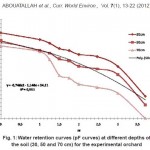 |
Figure 1: Water retention curves (pF curves) at different depths of the soil (30, 50 and 70 cm) for the experimental orchard Click here to View table |
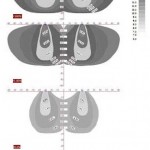 |
Figure 2: Spatial distribution of the soil water content on the open field treatments F200%, F100% and F50% Click here to View table |
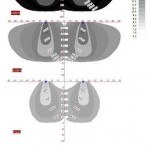 |
Figure 3: Soil moisture distribution on treatments under shade S200%, S100% and S50% Root profiles Click here to View table |
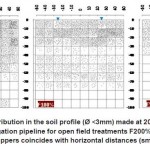 |
Figure 4: Roots spatial distribution in the soil profile (Ø <3mm) made at 20 cm from tree trunk and just underneath the irrigation pipeline for open field treatments F200%, F100% and F50%; the placement of the 2 drippers coincides with horizontal distances (small triangles ±30cm). Click here to View table |
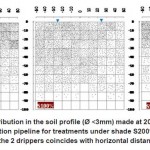 |
Figure 5: Roots spatial distribution in the soil profile (Ø <3mm) made at 20 cm from tree trunk and just underneath the irrigation pipeline for treatments under shade S200%, S100% and S50%; the placement of the 2 drippers coincides with horizontal distances (±30cm). Click here to View table |
Fruit growth: we randomly selected four trees per treatment; each one was marked with eight fruits for which the equatorial diameter was measured weekly.
Fruit dropping intensity: the number of dropped fruits has been counted three times a week during the month of May to compare its intensity for the three treatments applied (200% x 50%) in the two plots under nets and on open field. Repetitions and trees concerned were the same as those from fruit growth measurements.
Results and Discussion
Water Retention Curve or pF Curve
Values in Fig. 1 are relative to different soil depths. The observed difference concerns water retention capacity between the three soil depths because of variations in soil micro porosity and soil texture, which varies between the three horizons. The average curve of 50cm binding soil water pressure potential with soil volumetric water content has a polynomial form: y = -0.746x2 – 1.146x + 34.21
Soil moisture is calculated from trends using equations at field capacity (HFC=pF2) and at permanent wilting point (HPWP=pF4.2)49-50,41 (Table 1). Available soil moisture is determined as the interval between the water content at field capacity and permanent wilting point.51
Treatments at Open Field
We note a good water distribution into the soil for the open field treatments F200% and F100% (Fig. 2); soil moisture never approaches the HPWP, but water have been lost until 70cm and 90cm of soil depth for treatments F100% and F200% respectively due to the high amount of water applied in both two cases. A better lateral distribution took place on treatment F50%, however soil moisture was below HPWP at the horizons of 40-60cm depth (Figure 2), indeed, deficit irrigation significantly reduces the wetted soil volume52; this can strongly prevent the development of roots at these levels; we observed 95% of root hairs at only 30 cm of soil depth; the F50% dose seems to be insufficient for citrus crops grown on open field.
Treatments Under Shade
We note, again, a good water distribution into the soil for the treatments under shade S200% and S100% (Fig. 3); but with high soil moisture at deep horizons below 70 cm. similar soil flooding causes less root hydraulic conductance in citrus, so a reduction in transpiration by 56%.53 The soil water content is well distributed laterally on treatment S50% (Fig. 3), the bulb’s depth is about 50 cm where the majority of roots are located; it seems that the shade screens helped to reduce evapotranpiration and to keep water into the soil. This result is in concordance with some other authors who founded sap flow in shaded trees is lower than in exposed trees almost every day.18,19
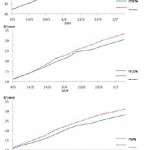 |
Figure 6: Fruit size growth for all treatments under shade and on open field.Fruit dropping intensity Click here to View table |
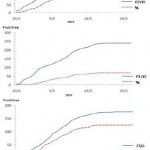 |
Figure 7: Fruits cut number per tree for all treatments under shade and on open field Click here to View table |
Root Profiles
In this report, we are only presenting results for the root hairs with diameter < 3 mm.
Treatments at Open Field
The greatest number of roots was counted on the open field treatment F200% (3293/m2), almost 90% of the feeder roots are concentrated at less than 60 cm depth; nevertheless, we could found some active roots until 100cm due to the very deep soil water bulb (Fig. 4). Roots were better distributed for the open field treatment F100% (2333/m2), the last roots are found at 80 cm depth. These results confirm what other authors say that the root system architecture is largely affected by irrigation.54 Trees from treatment F50% developed very few root hairs (1625/m2) at superficial horizons only (95% at 30cm depth); it means 50% compared to the F200%; other author have found that root length density is reduced by H”73% because of the continuous deficit irrigated55; this root reaction is to be explained by the restricted water supply which brings superficial soil moisture; however, a good horizontal distribution of these roots is observed, which proves that soil humid bulbs overlap under the emitters which is also in relation with the loamy nature of the soil.
Treatments Under Shade
The trees from the treatment S200% developed deep roots until 90cm with a total number of 3267/m2; nevertheless, almost 90% of the feeder roots are concentrated at less than 70 cm depth. With a total of 2652/m2, roots were better distributed for the treatment S100% horizontally as well as vertically, the last roots are found at 85 cm depth (Fig. 5). Trees from treatment S50%, growing under shelter, developed good number of root hairs (2516/m2); almost 90% of them are at 50cm depth and very well distributed horizontally (Fig. 5).
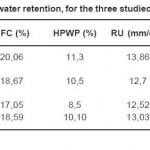 |
Table 1: Soil water retention, for the three studied horizons Click here to View table |
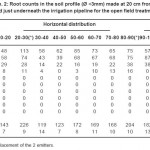 |
Table 2: Root counts in the soil profile (Ø <3mm) made at 20 cm from tree trunk and just underneath the irrigation pipeline for the open field treatment F50% Click here to View table |
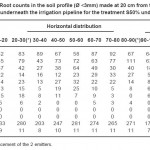 |
Table 3: Root counts in the soil profile (Ø <3mm) made at 20 cm from tree trunk and just underneath the irrigation pipeline for the treatment S50% under shade Click here to View table |
The Comparison Between Open Field Trees and those Under Shade Brings to Say
- Roots number and distribution are almost the same for treatments 200% with deeper water bulbs.
- Roots are very well distributed for treatments receiving 100% of their water requirements;
- For treatments under 50% of water stress, the difference on root profiles is notable. The roots number is greeter under shade (2516/m2 against 1625/m2) and well distributed; this might be explained by a better distribution of the soil moisture in the different horizons thanks to the less crop water requirement under shade (Table 2 and 3).
Fruit Size
The Fig. 6 and statistical analysis indicates no significant difference between the three doses. In addition, the use of the shade screens coupled with treatment 200% and 100% does not affect the growth of fruit trees. But, when using the dose of 50%, the fruit growth is enhanced under shade compared to the open field; some authors reported that the best integrated daily water-use efficiency corresponded to the shaded citrus treatments.56
Fruit Dropping Intensity
Fig. 7 shows that fruit drop is higher for the dose of F200% with a total of 341 fruit dropped while, for treatment F50%; this value is only 176 (≈50% less); however, other author found that a partial drying do not induce excessive fruit drop and crop yield is kept unaffected57; Also, for all treatments it was evident that fruit dropping phenomena depends a lot on the use or not of the shade screens that seems to reduce considerably the rate of fruit drop especially for the treatments 100% and 50%.
Conclusion
Better water use efficiency is no longer an aim of citrus growers but necessity for sustainability of agriculture in the Souss-Massa region. The use of the shading net helped to decrease fruit dropping, but had no effect on the fruit size growth. Roots distribution and soil moisture measurements showed that the 100% and 200% doses provided the plant with excess water percolating into deeper horizons, which was behind the establishment of roots beyond 60 cm; in contrast, those ones confined in the upper layers of 50 cm depth when trees are under shade and irrigated using 50% dose. We may conclude that adopting 50% of tree’s water requirements using net are a good way to maximize irrigation water efficiency without affecting the tree growth and their physiological state.
References
- Agence du Bassin Hydraulique du Souss Massa (ABHSM), Etude de révision du plan directeur d’aménagement intégré des ressources en eau des bassins du souss massa, Document interne, (2006).
- Le Houerou H. N., Ecologia Mediterranea.,15: 95 (1989).
- Driouech F., Déqué M., Sánchez-Gómez E.,Global. Planet. Change., 72: 1 (2010).
- Ministère de l’Aménagement du Territoire, de l’Urbanisme, de l’Habitat et de l’Environnement du Maroc (MATUHE), First National Communication, United Nations Framework Convention on Climate change, 99 (2001).
- Office régional de mise en valeur agricole du Souss Massa (ORMVASM), Etude de gestion intégrée des ressources en eau dans le Souss Massa., Document interne, (2007).
- Edwards C. A., Agric. Ecosyst. Environ., 27 : 25 (1989).
- Tejero I. G., Zuazo V. H. D., Bocanegra J. A. J., Fernández J. L. M., Sci. Hort., 128: 274 (2011).
- Nicolás E., Barradas V. L., Ortuño M. F., Navarro A., Torrecillas A., Alarcón J., Environ. Exp. Bot., 63:200 (2008).
- Castellano S., Scarascia G. M., Russo G., Briassoulis D., Mistriotis A., Hemming S., Waaijenberg D., Appl. Eng. Agric., 24: 799 (2008).
- Medany A. M., Hassanein M. K., Farag A. A., Acta Hortic., 807: 121 (2009).
- Hemming S., Swinkels G. L. A. M., Castellano S., Russo G., Scarascia G. M., Agricultural and Biosystems Engineering for a Sustainable World., 42:23 (2008).
- Briassoulis D., Mistriotis A., Eleftherakis D., Polym. Test., 20: 970 (2007).
- Tanny J., Cohen S., Biosystems Eng., 84: 57 (2003).
- Nicolás E ., Torrecillas A., Dell’Amico J.,Alarcón J. J., J. Plant Physiol., 162: 439 (2005).
- Cohen S., Raveh E., Li Y., Grava A., Goldschmidt E. E., Sci. Hort., 107: 25 (2005).
- Stanhill G., Cohen S., Agric. Forest Meteorol.,107: 255 (2001).
- Muthuchelian K., Paliwal K.,Gnanam A., Plant. Sci., 99:539 (1989).
- Alarcón J. J., Ortuño M. .F, Nicolás E., Navarro A., Torrecillas A., Agric. Water Manage., 82:387 (2006).
- Nicolás E., Torrecillas A., Dell’Amico J., Alarcón J. J., J. Plant Physiol., 162: 439 (2005).
- Medina L. C., Souza P. R., Machado C. E., Ribeiro V. R., Silva A. B. J., Sci. Hort., 96: 115 (2002).
- Talamini do Amarante C. V., Steffens C. A., Argenta L. C., Sci. Hort., 129: 79 (2011).
- Lei Y. B., Yin C. Y., Li C. Y. Physiol Plant., 127: 182 (2006).
- Rodríguez-Gamir J., Ancillo G., Aparicio ., Bordas M., Primo-Millo E. , Plant Soil., 347: 91 (2011).
- Arbona V., Iglesias D. J., Jacas J., Primo-Millo E., Talon M., Gomez-Cadenas A., Plant Soil.,270: 73 (2005).
- Garcia-Sanchez F., Syvertsen J. P., Gimeno V., Botia P., Perez-Perez J. G., Physiol. Plantarum., 130:532 (2007).
- Perez-Perez J. G., Syvertsen J. P., Botia P., Garcia-Sanchez F., Ann. Bot., 100: 335 (2007).
- Gomez-Cadenas A., Tadeo F. R., Talon M., Primo-Millo E., Plant Physiol., 112: 401 (1996).
- Velez J. E., Intrigliolo D. S., Castel J. R., Agric. Water Manage., 90:197 (2007).
- Ballester C., Castel J., Intrigliolo D. S., Castel J. R., Agric. Water Manage., 98: 1027 (2011).
- García-Tejero I., Jiménez-Bocanegra J. A., Martínez G., Romero R., Durán-Zuazo V. H., Muriel-Fernández J. L., Agric. Water Manage., 97: 614 (2010).
- García-Tejero I., Durán-Zuazo V. H., Arriaga-Sevilla J. and Muriel-Fernández J. L., Agron.Sustainable Dev., 31: 779 (2011).
- Xu-Ming H., Hui-Bai H., Fei-Fei G., Sci. Hort.,83: 227 (2000).
- Agusti M., Garcia-Mari F., Guardiola J. L., Sci.Hortic., 17: 257 (1982).
- Goldschmidt E. E., Monselise S. P., Proc. Int.Soc. Citriculture., 2: 668 (1977).
- García-Tejero I., Romero-Vicente R.,Jiménez-Bocanegra J. A., Martínez-García G., Durán-Zuazo V. H., Muriel-Fernández J. L., Agric. Water Manage., 97: 689 (2010).
- Romero P., Navarro J. M., Perez-Perez J., Garcia-Sanchez F., Gomez-Gomez A., Porras I., Martinez V., Botia P., Tree Physio., 26: 1537 (2006).
- Gonzalez-Altozano P., Castel J. R., J. Hortic. Sci. Biotechnol., 74: 706 (1999).
- Gonzalez-Altozano P., Castel J. R., J. Hortic. Sci. Biotechnol., 75: 388 (2000).
- Ginestar C., Castel J. R., J. Hortic. Sci., 71:551 (1996).
- Treeby M. T., Henriod R. E., Bevington K. B., Milne D. J., Storey R., Agric. Water Manage., 91: 24 (2007).
- Treeby M. T., Henriod R. E., Bevington K. B., Milne D. J., Storey , Agric. Water Manage., 91: (2007).
- García-Tejero I., Durán-Zuazo V. H., Jiménez-Bocanegra J. A., Muriel-Fernández J. L., Sci.Hortic., 128: 274 (2011).
- Abu-Awwad A. M., Agric. Water Manage., 52: 53 (2001).
- Fares A., Safeeq M., Jenkins D. M.,Pedosphere., 19: 588 (2009).
- Allen R. G., Periera L. S., Raes D., Smith M.,Crop evapotranspiration: guideline for computing crop water requirement. FAO,Rome, Italy, 301 (1998).
- Milind S., Ladaniya A., Academic Press., 1:13 (2008).
- Nadori E. B., Revue HTE., 132: 15 (2005).
- Hanson R. B., Orloff S., Peters D., Calif Agric.,54: 47 (2000).
- Jabro J. D., Evans R. G., Kim Y., Iversen W.M., Irrig Sci., 27, 223 (2010).
- Ratliff L. F., Ritchie J. T., Cassel D. K., Soil SciSoc Am J., 47 : 770 (1983).
- Castel J. R., Buj A., Irrig. Sci., 11: 121 (1990).
- Hutton R. J., Loveys B. R., Agric. WaterManage., 98: 1485 (2011).
- 53. Rodríguez-Gamir J., Ancillo G., González-Mas M. C., Primo-Millo E., Iglesias D. J.,Forner-Giner M. A., Plant Physiol. Biochem.,49: 636 (2011).
- Sokalska D. I., Haman D. Z., Szewczuk A.,Sobota J., Dereñ D., Agric. Water Manage.,96: 917 (2009).
- Abrisqueta J. M., Mounzer O., Álvarez S.,Conejero W., García-Orellana Y., Tapia L. M.,Vera J., Abrisqueta I., Ruiz-Sánchez M. C., Agric. Water Manage., 95: 959 (2008).
- Alarcón J. J., Ortuño M. F., Nicolás E., NavarroA., Torrecillas A., Agric. Water Manage., 82:387 (2006).
- Hutton R. J., Loveys .B R., Agric. Water Manage., 98: 1485 (2011).






